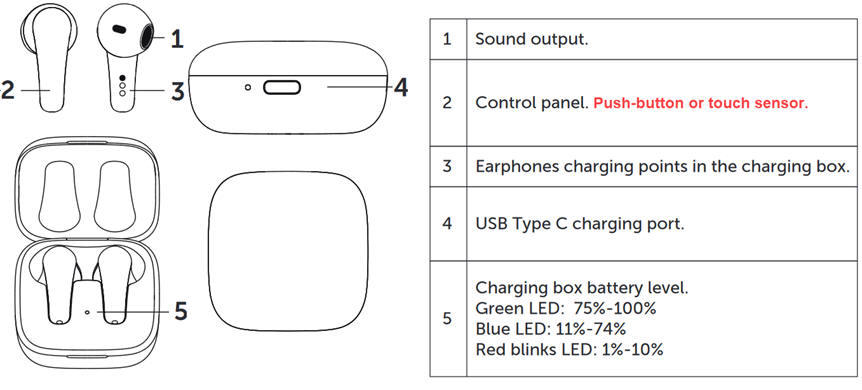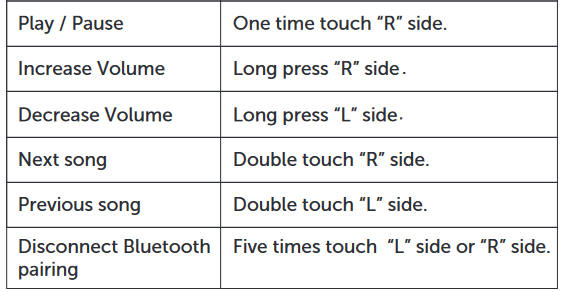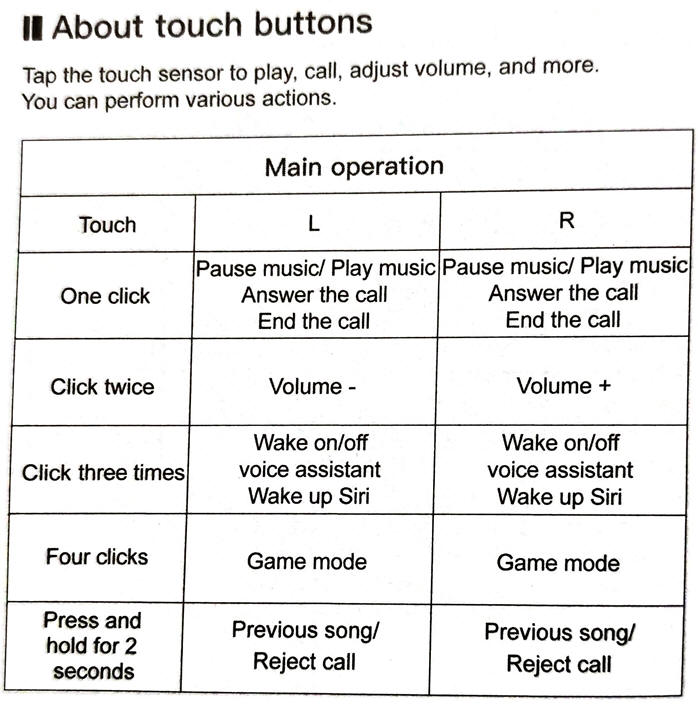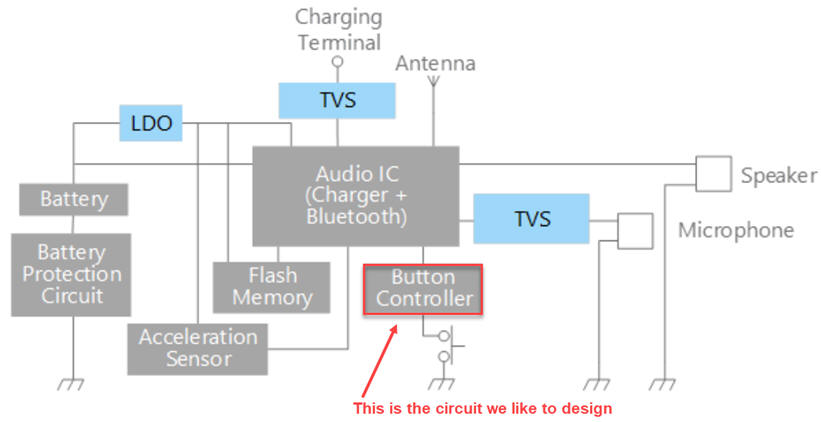|
|
|||||
Chapter 3 problems |
- D3.23 - |
Earbuds control buttons (μC - C) |
|||
|
|
|||||
1. Specifications
Design the button decoder (BTN_cntl) that is typical in many commercial Bluetooth earbuds targeting a PIC18F4520 microcontroller chip. The idea is to assign a binary code to each function once detected. Fig. 1 shows a typical pair of commercial earbuds. Indeed, the final product for such space-constrained application, better be implemented in ultra-small 2 mm x 3 mm Dual Flat No-lead (DFN) 6-8pin package μC such PIC10L3xx or ATtiny102.
The same project designed using hardware is stated in D2.23.
 |
| Fig. 1. Example wireless commercial earbuds. Only one tactile pushbutton or capacitive touch sensor is available for commanding operations. |
Once paired, depending on the apps selected in the mobile phone, earbuds can be used for answering phone calls, voice assistance or playing music. Functions assgned to short and long clicks depends on the model and the earbud branch. Let us consider option #1 simplified in Fig. 2 where only typical music player functions are listed.
Option #1 example functions and actions:
 a) |
| Fig. 2 a) Example especifications when used as music player. |
Option #2 example functions and actions for multiple applications: call, music, gaming.
 b) |
| Fig. 2b) Example especifications when used for phone, music and gaming apps. |
An internal switch S may be used to select left or right earbuds. For example S = '0' is the right earbud, S = '1' is the left earbud.
The idea is organise a FSM to detect one, two or five continuous short clicks, and also a long press. Fig. 3 shows a block diagram of an earbud from Toshiba company.
 |
Fig. 3. Block diagram of an earbud. Reference paper: wireless earphone solution for long time operation with a small battery on a wireless earphone. TVS stands for transient voltage suppressor diodes to prevent the destruction of the electronics due to electrostatic discharges (ESD). LDO is a low dropout voltage regulator. |
Experiment in a protoboard and characterise the signals from a typical push-button. What is the typical time duration of a short and a long pulse?
2. Planning
Let us build the product organising several design phases, and several steps within each phase.
First of all, we have to imagine how the captured signal will look like. How many samples do you need to identify the three patterns. What is the typical short click duration? Draw some waveforms in a timing diagram as in Fig. 4.
Fig. 4. Example timing diagram when clicking PBL several times. We can consider several situations, one short chick is one of two '1' detected. The separation between short clicks is one or two CLK periods. Thus, a signal capture window of seven samples is required before analysing the waveform and deciding which function assign. |
Thus, an easy way to infer how the circuit may be conceived is to use an external interrupt INTx (x = 0, 1, or 2) to start the acquisition when the active PB_L falling edge is detected. Then we can use an external CLK = 8 Hz (another INTx) to acquire the seven or eight samples reading the same PB_L value in order to generate the RAM variable var_captured_pattern.
Design phase #1: basic features
Solve the circuit for the design step #1. Only when it is fully tested working correctly and reported, solve the design step #2.
Design step #1. Consider an initial circuit with no side S switch. Verify that the signal acquisition mechanism works.
Project location:
C:\CSD\P10\BTN_cntl_s1\(files)
Project source files:
BTN_cntl.pdsprj, BTN_cntl.c
a) Draw the hardware schematic necessary for step #1. PB_L push button, CLK push button or oscillator (8 Hz), output LED_pattern, reset circuit MCLR_L, and an 8 MHz quartz crystal oscillator. Explain how to configure the inputs and outputs in init_system().
b) Draw the function table and the state diagram indicating state transitions and outputs.
c) Draw the hardware/software diagram indicating the required RAM variables and how the FSM is solved in software.
d) Draw the truth tables and their equivalent flowcharts for state_logic() and output_logic() functions.
e) What is the interrupt service routine ISR() used in this application? Draw its flowchart.
f) Develop and test (debugging) the project capturing the hardware circuit in Proteus and writting the C source code.
Design step #2. Add the S switch to decode all the left and right functions.
Inherit the step #1 source hardware and software files into de new location.
Project location:
C:\CSD\P10\BTN_cntl_s2\(files)
Project source files:
BTN_cntl.pdsprj, BTN_cntl.c
a) Draw the hardware schematic necessary for step #2. Add the new switch and resistor for input S. Explain how to configure it in init_system().
Explain what is new in sections b), c), d), e), f)
Develop and test the new feature.
Let us add an LCD display as studied in P11 to this application. In this way, the LED_pattern output can be replaced by the LCD written message "Increase volume", "Play", etc.
Project location:
C:\CSD\P11\BTN_cntl_LCD\(files)
Project source files:
BTN_cntl_LCD.pdsprj, BTN_cntl_LCD.c
g) Enhance the schematic from the previous design phase #1 to include an LCD attached to port D as studied in tutorials.
h) Enhance the software and the source file to drive the LCD.
Develop and test the new feature.
Design phase #3: Using TMR2 peripheral subsystem.
Design step #1. TMR2 to replace the external sampling CLK
The external sampling CLK is replaced by the internal 8-bit TMR2 peripheral to generate interrupts (TMR2IF). Discuss the main features of this peripheral and its applications.
Project location:
C:\CSD\P12\BTN_cntl_LCD_TMR2\(files)
Project source files:
BTN_cntl_LCD_TMR2.pdsprj, BTN_cntl_LCD_TMR2.c
i) Calculate TMR2 parameters required to generate a CLK of 8 Hz (var_CLK_flag period = 125 ms) to acquired the pattern and run the machine replacing the external CLK signal.
Develop and test the new feature.
Design step #2. TMR0 to generate a sleep signal
j) Add a new TMR0 to generate a new switch off (sleep mode) signal after 1 min of inactivity.
Project location:
C:\CSD\P12\BTN_cntl_LCD_TMR2_TMR0\(files)
Project source files:
BTN_cntl.pdsprj, BTN_cntl.c
Develop and test the new feature.


